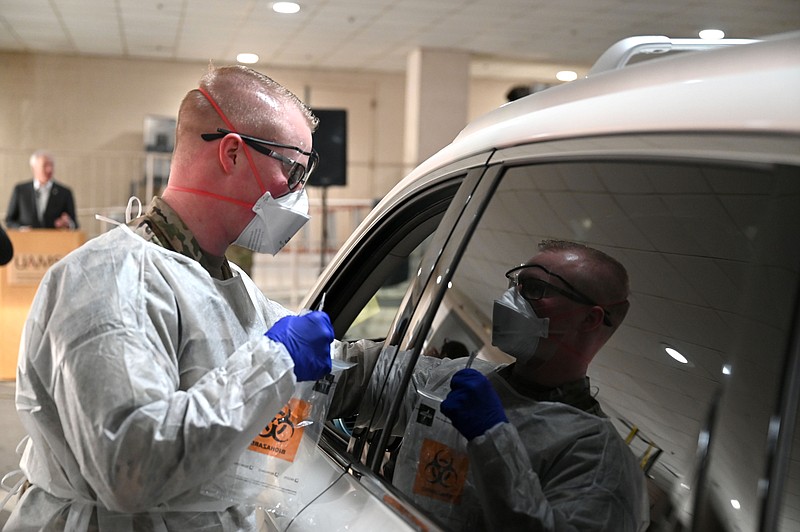After a slowdown around Memorial Day, Arkansas' count of coronavirus cases rose Thursday by 635 -- the biggest one-day jump in more than two months -- as the number of people hospitalized in the state with the virus topped 100 for the first time since early April.
The state's death toll from the virus, as tracked by the Arkansas Department of Health, rose by four, to 11,492.
The increase in cases was larger by 169 than the rise on Wednesday and by 262 than the one the previous Thursday.
It was the largest one-day spike since March 21, a time when the state's new case numbers were inflated by a backlog of reports that had been faxed in weeks earlier, during a surge of infections from the omicron variant.
Growing by double digits for the second straight day, the number of covid-19 patients in the state's hospitals rose Thursday by 13, to 105.
It was the first time covid hospitalizations exceeded 100 since April 5.
State Epidemiologist Mike Cima said the jump in new cases appeared to be the continuation of an upward trend in infections, blamed in part on a new, more contagious version of omicron known as BA.2.12.1, that began a few days after Easter.
Gatherings over Memorial Day weekend, as well as a catch-up in reporting after the holiday, may also have contributed to the spike, he said.
"I'm sure that some of these cases are from before the holiday weekend, but looking at the cases distributed by their dates of result or date of symptom onset, it's clear that a sizeable chunk of them became sick after the holiday," Cima said.
The number hospitalized, while up by more than 200% from the low of 40 reached this year in early May, remained below the lowest level it reached last year, which was 141 on April 8, 2021.
During the omicron surge this winter, the number reached an all-time high of 1,819 on Jan. 26.
"We will probably see some increases in hospitalizations," Cima said. "To what extent, it kind of remains to be seen.
"If other states are any lesson to us, then they'll increase minorly to moderately but won't explode."
After falling the previous two days, the average daily increase in Arkansas' case count over a rolling seven-day period rose Thursday to 345, which was still down from a recent high of 358 on Monday.
With new cases outnumbering recoveries, the number of cases in the state that were considered active rose Thursday by 280, to 4,160, the largest total since March 2.
After rising by two a day earlier, the number of the state's virus patients who were on ventilators remained Thursday at seven.
The number in intensive care also didn't change, remaining at 18 on Thursday after rising by six on Wednesday.
At its hospitals in Little Rock and Springdale, Arkansas Children's had eight covid-19 patients on Thursday, down from nine on Wednesday, spokeswoman Hilary DeMillo said.
MAP UPDATED
Despite the uptick in new cases, all 75 of Arkansas' counties were labeled as having a "low" level of covid-19 under the latest update to the U.S. Centers for Disease Control and Prevention's map of "covid-19 community levels."
In addition to new cases, the levels are based on hospital admissions for covid-19 and the percentage of hospital beds that are occupied by covid-19 patients.
Under the previous weekly update, Ashley and Chicot counties were labeled as having a "medium" covid-19 level due to the number of hospital admissions in the two counties the week ending May 24.
During the week ending Tuesday, admissions in the two counties, which share a service area used by the CDC to calculate hospital metrics, translated to a rate of 6.7 per 100,000 residents.
That was below the cutoff of 10 per 100,000 that results in a county's level being at least medium regardless of its number of new cases.
Arkansas' 73 other counties had already been labeled as having a low level before the update on Thursday.
It was the ninth week in a row that no county in the state had a "high" covid-19 level, which triggers a recommendation that people wear masks in indoor public places.
In counties with a medium level, the CDC recommends people who are immunocompromised or at high risk of severe covid-19 talk to their health care providers about whether they should wear masks or take other precautions.
People in those counties also should consider wearing masks around people who have a high risk of severe illness, according to the CDC.
In counties with low covid-19 levels, the CDC doesn't have a recommendation about whether people should wear masks.
CASES BY COUNTY
Pulaski County had the most new cases, 122, on Thursday, followed by Washington County with 63 and Benton County with 52.
The state's cumulative count of cases since March 2020 grew to 844,463.
The Health Department's tally of vaccine doses that had been administered rose by 1,396, which was down 386 from the daily increase a week earlier.
The number of people receiving the vaccine for the first time rose 232, which was down by more than 200 from the increase in first doses a week earlier.
According to the CDC, the percentage of Arkansans who had received at least one dose remained Thursday at 67.1%, and the percentage who were fully vaccinated remained at 54.8%.
The percentage of those fully vaccinated who had receive a booster dose remained at 40.2%.
Among the states and District of Columbia, Arkansas continued to rank 37th in the percentage of its residents who had received at least one dose.
In the percentage who were fully vaccinated, it continued to be roughly tied with Tennessee for 46th, ahead of Louisiana, Mississippi, Alabama and Wyoming.
Nationally, 77.9% of people had received at least one dose, and 66.7% were fully vaccinated.
Of the fully vaccinated population nationally, 46.8% had received a booster dose.
